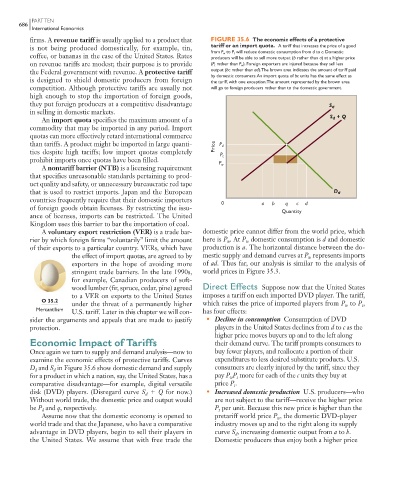Page 777 - Economics
P. 777
CONFIRMING PAGESAGES
CONFIRMING P
PART TEN
686
International Economics
firms. A revenue tariff is usually applied to a product that FIGURE 35.6 The economic effects of a protective
is not being produced domestically, for example, tin, tariff or an import quota. A tariff that increases the price of a good
from P w to P t will reduce domestic consumption from d to c . Domestic
coffee, or bananas in the case of the United States. Rates producers will be able to sell more output ( b rather than a ) at a higher price
on revenue tariffs are modest; their purpose is to provide ( P t rather than P w ). Foreign exporters are injured because they sell less
the Federal government with revenue. A protective tariff output ( bc rather than ad ). The brown area indicates the amount of tariff paid
by domestic consumers. An import quota of bc units has the same effect as
is designed to shield domestic producers from foreign the tariff, with one exception: The amount represented by the brown area
competition. Although protective tariffs are usually not will go to foreign producers rather than to the domestic government.
high enough to stop the importation of foreign goods,
they put foreign producers at a competitive disadvantage S d
in selling in domestic markets.
S d + Q
An import quota specifies the maximum amount of a
commodity that may be imported in any period. Import
quotas can more effectively retard international commerce
than tariffs. A product might be imported in large quanti- Price P d
ties despite high tariffs; low import quotas completely
P t
prohibit imports once quotas have been filled.
P w
A nontariff barrier (NTB) is a licensing requirement
that specifies unreasonable standards pertaining to prod-
uct quality and safety, or unnecessary bureaucratic red tape
that is used to restrict imports. Japan and the European D d
countries frequently require that their domestic importers 0
of foreign goods obtain licenses. By restricting the issu- a b q c d
Quantity
ance of licenses, imports can be restricted. The United
Kingdom uses this barrier to bar the importation of coal.
A voluntary export restriction (VER) is a trade bar- domestic price cannot differ from the world price, which
rier by which foreign firms “voluntarily” limit the amount here is P . At P domestic consumption is d and domestic
w
w
of their exports to a particular country. VERs, which have production is a . The horizontal distance between the do-
the effect of import quotas, are agreed to by mestic supply and demand curves at P represents imports
w
exporters in the hope of avoiding more of ad . Thus far, our analysis is similar to the analysis of
stringent trade barriers. In the late 1990s, world prices in Figure 35.3 .
for example, Canadian producers of soft-
wood lumber (fir, spruce, cedar, pine) agreed Direct Effects Suppose now that the United States
to a VER on exports to the United States imposes a tariff on each imported DVD player. The tariff,
O 35.2
under the threat of a permanently higher which raises the price of imported players from P to P ,
w
t
Mercantilism U.S. tariff. Later in this chapter we will con- has four effects:
sider the arguments and appeals that are made to justify • Decline in consumption Consumption of DVD
protection. players in the United States declines from d to c as the
higher price moves buyers up and to the left along
Economic Impact of Tariffs their demand curve. The tariff prompts consumers to
Once again we turn to supply and demand analysis—now to buy fewer players, and reallocate a portion of their
examine the economic effects of protective tariffs. Curves expenditures to less desired substitute products. U.S.
D and S in Figure 35.6 show domestic demand and supply consumers are clearly injured by the tariff, since they
d
d
for a product in which a nation, say, the United States, has a pay P P more for each of the c units they buy at
w t
comparative disadvantage—for example, digital versatile price P .
t
disk (DVD) players. (Disregard curve S Q for now.) • Increased domestic production U.S. producers—who
d
Without world trade, the domestic price and output would are not subject to the tariff—receive the higher price
be P and q , respectively. P per unit. Because this new price is higher than the
t
d
Assume now that the domestic economy is opened to pretariff world price P , the domestic DVD-player
w
world trade and that the Japanese, who have a comparative industry moves up and to the right along its supply
advantage in DVD players, begin to sell their players in curve S , increasing domestic output from a to b .
d
the United States. We assume that with free trade the Domestic producers thus enjoy both a higher price
9/14/06 9:49:49 PM
mcc26632_ch35_674-695.indd 686 9/14/06 9:49:49 PM
mcc26632_ch35_674-695.indd 686

